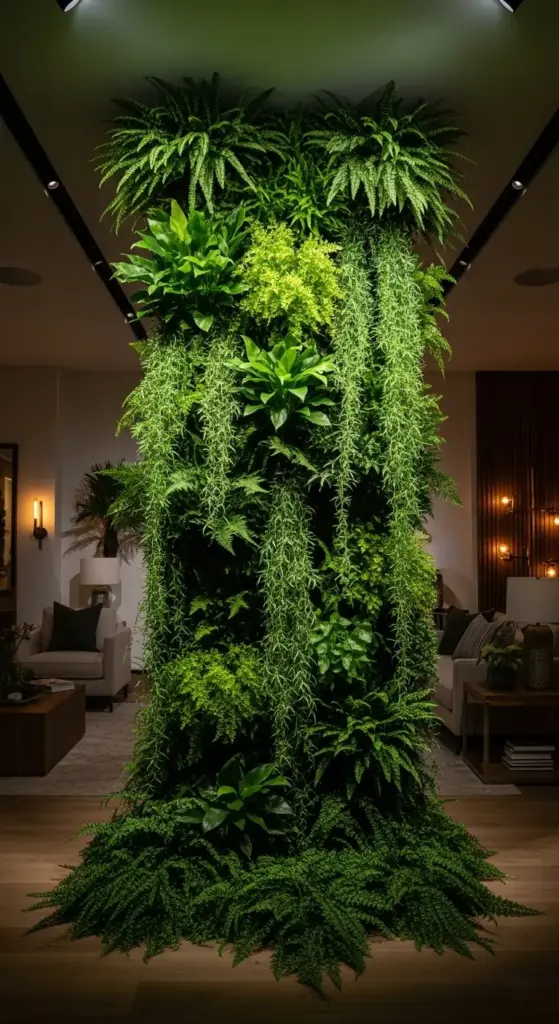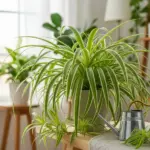6. The Dramatic Fern Wall Backdrop

Walking into my friend’s Brooklyn loft and seeing her massive fern wall backdrop was like stepping into a tropical rainforest. The entire living room felt like a jungle paradise, and I immediately knew I had to recreate that magic.
Spoiler alert: ferns are way more dramatic than I expected.
My first attempt looked like I’d randomly stuck a few sad ferns on the wall and hoped for the best. Half of them turned brown within two weeks, and the whole thing just looked… pathetic.
Creating That Lush Tropical Vibe
The secret to dramatic fern displays is understanding that ferns are all about volume and texture, not individual plant beauty.
Start with a large backdrop area – at least 6 feet wide and 8 feet tall. Tropical wall features need space to make an impact.
Layer different fern heights and textures. I use tall tree ferns in the back, medium Boston ferns in the middle, and trailing varieties in front.
The game-changer for me – mount ferns at different depths from the wall. This creates that natural forest layering effect that looks so lush.
Use a mix of hanging planters, wall-mounted pots, and floor planters to create visual depth in your living wall installation.
Fern Varieties That Won’t Let You Down
After killing probably fifteen different fern varieties, I’ve narrowed down the ones that actually thrive in indoor conditions.
Boston ferns are absolutely bulletproof once you get their watering schedule down. Mine have been thriving for over a year now.
Maidenhair ferns are gorgeous but finicky. They need consistent humidity and hate being moved around.
Bird’s nest ferns are perfect for beginners – they’re nearly impossible to kill and have this amazing architectural shape that adds structure to fern wall designs.
Staghorn ferns mounted on wood create incredible focal points, though they need more attention than other varieties.
Rabbit’s foot ferns have these cool fuzzy rhizomes that add texture and are surprisingly low-maintenance.
Humidity and Lighting Secrets
This is where most indoor fern gardens fail. Ferns are basically humidity addicts, and regular house air just doesn’t cut it.
I run a humidifier near my fern wall backdrop during winter months when indoor air gets super dry. Target 50-60% humidity if possible.
Bright, indirect light is the sweet spot. My ferns sit about 8 feet from a large north-facing window and absolutely love it.
Avoid direct sunlight at all costs – I learned this when my beautiful maidenhair fern got crispy in just one afternoon of direct sun.
LED grow lights work amazingly well for fern walls in darker spaces. I use full-spectrum strips mounted above the display.
Group ferns together to create their own microclimate. They actually help each other maintain humidity levels.
Styling as Room Dividers
Fern room dividers are having a major moment, and honestly, they’re so much more interesting than traditional screens.
I use tall plant stands at different heights to create a living wall that separates my living and dining areas. It feels way more organic than a solid divider.
Hanging fern displays work perfectly for defining spaces without blocking light completely.
The trick is varying heights and depths – you want some visual breaks so the space doesn’t feel completely closed off.
Consider mobility if you’re renting. I use wheeled plant stands so I can rearrange my tropical wall features whenever I want.
Creating Stunning Focal Points
A well-designed fern wall should be the first thing people notice when they walk into your room.
Lighting is everything for focal points. I installed picture lights above my main fern display, and the dramatic shadows create such a moody atmosphere.
Use one large, architectural fern as your anchor plant, then build around it with smaller varieties.
Color variation matters more than you think – mix different shades of green from deep forest to bright lime for visual interest.
Textural contrast is key. Pair delicate, lacy ferns with bold, structural varieties for maximum impact.
Pairing with Furniture and Accessories
The beauty of tropical home decor is how it transforms your entire space, not just the plant area.
Natural materials work perfectly with fern walls. I use rattan furniture, jute rugs, and wood accents to enhance the jungle vibe.
Earth-tone color palettes complement fern displays beautifully. Think warm browns, deep greens, and creamy whites.
Metallic accents add sophistication – brass planters and copper watering cans prevent the space from feeling too rustic.
Textured fabrics like linen and cotton enhance the natural, organic feeling of living wall designs.
Maintenance That Actually Works
Fern care is all about consistency once you establish a routine.
Water when the top inch of soil feels dry, but never let ferns completely dry out. I check mine every 3-4 days.
Misting helps with humidity, but don’t overdo it. Too much moisture on leaves can cause fungal problems.
Remove brown fronds immediately – they’re not coming back and they make the whole display look sad.
Fertilize monthly during growing season with diluted liquid fertilizer. Ferns are light feeders, so less is more.
Seasonal Care Adjustments
Indoor fern walls need different care as seasons change, even though they’re inside.
Winter means less water and more humidity support. I move my humidifier closer during heating season.
Spring is growth time – increase watering and start fertilizing again after winter dormancy.
Summer requires more frequent watering but watch for overwatering in humid weather.
Fall is perfect for propagating and expanding your fern collection as they prepare for winter rest.
The vertical gardening trend with ferns creates such a dramatic, sophisticated look that never goes out of style.
Ready to grow your own fresh vegetables on the wall? Click below to discover how to create a self-watering vertical vegetable garden that produces fresh food year-round – even in the tiniest kitchen spaces!









GIPHY App Key not set. Please check settings